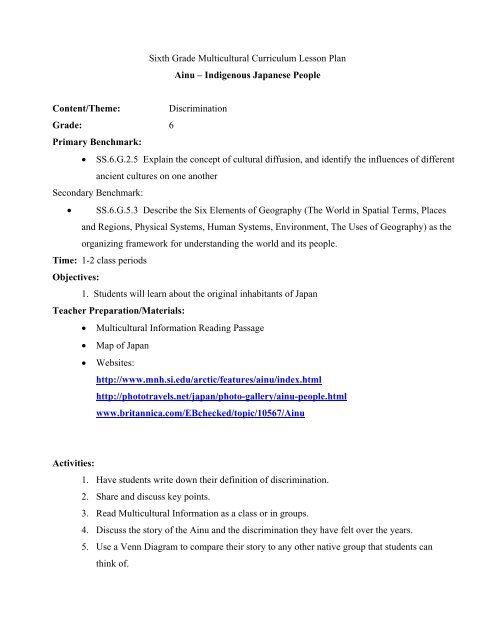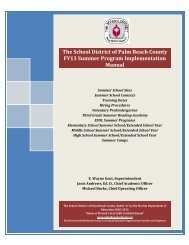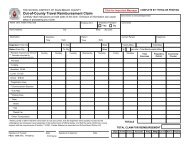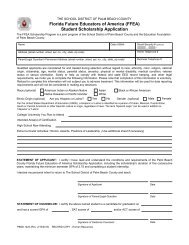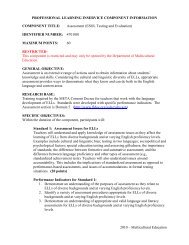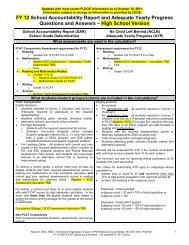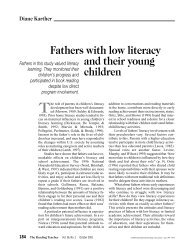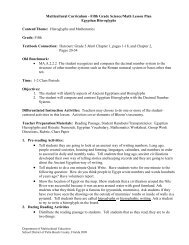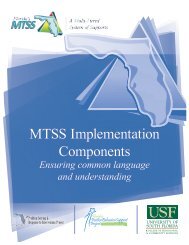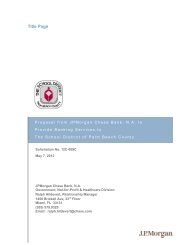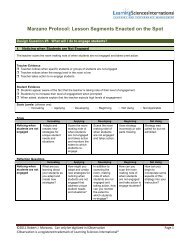Kindergarden Multicultural Curriculum Lesson Plan - The School ...
Kindergarden Multicultural Curriculum Lesson Plan - The School ...
Kindergarden Multicultural Curriculum Lesson Plan - The School ...
You also want an ePaper? Increase the reach of your titles
YUMPU automatically turns print PDFs into web optimized ePapers that Google loves.
Sixth Grade <strong>Multicultural</strong> <strong>Curriculum</strong> <strong>Lesson</strong> <strong>Plan</strong><br />
Ainu – Indigenous Japanese People<br />
Content/<strong>The</strong>me: Discrimination<br />
Grade: 6<br />
Primary Benchmark:<br />
• SS.6.G.2.5 Explain the concept of cultural diffusion, and identify the influences of different<br />
ancient cultures on one another<br />
Secondary Benchmark:<br />
• SS.6.G.5.3 Describe the Six Elements of Geography (<strong>The</strong> World in Spatial Terms, Places<br />
and Regions, Physical Systems, Human Systems, Environment, <strong>The</strong> Uses of Geography) as the<br />
organizing framework for understanding the world and its people.<br />
Time: 1-2 class periods<br />
Objectives:<br />
1. Students will learn about the original inhabitants of Japan<br />
Teacher Preparation/Materials:<br />
• <strong>Multicultural</strong> Information Reading Passage<br />
• Map of Japan<br />
• Websites:<br />
http://www.mnh.si.edu/arctic/features/ainu/index.html<br />
http://phototravels.net/japan/photo-gallery/ainu-people.html<br />
www.britannica.com/EBchecked/topic/10567/Ainu<br />
Activities:<br />
1. Have students write down their definition of discrimination.<br />
2. Share and discuss key points.<br />
3. Read <strong>Multicultural</strong> Information as a class or in groups.<br />
4. Discuss the story of the Ainu and the discrimination they have felt over the years.<br />
5. Use a Venn Diagram to compare their story to any other native group that students can<br />
think of.
6. Have students think about a personal experience with discrimination. If not, have<br />
students think about a time when they remember someone being treated differently<br />
because of assumptions made about that person. Last, as students, ask them what their<br />
school or community has done to deal with discrimination.<br />
Review of <strong>Lesson</strong> and Assessment:<br />
1. Students will be evaluated on their participation in the discussion as well as their written<br />
assignment.<br />
2. Optional quiz<br />
ESOL Strategies:<br />
• Personalize the lesson<br />
• Use cooperative learning groups<br />
• Draw examples from the experiences of students<br />
Resources:<br />
Japan Local Government Center: http://www.jlgc.org/jlgcnews/025/ainu.htm<br />
Artic Studies Center: http://www.mnh.si.edu/arctic/features/ainu/index.html
<strong>Multicultural</strong> Information:<br />
Historians say the Ainu originally populated much of Japan, as<br />
well as some of the Russian held regions. <strong>The</strong> Ainu lived peacefully by<br />
hunting, gathering, and fishing in abundant, coastal rivers.<br />
<strong>The</strong> Aniu now live on the islands of Hokkaido. <strong>The</strong>y are the<br />
original inhabitants of Japan, but they differ greatly from the ethnic<br />
Japanese. Not only is their language different, they look different as<br />
well. <strong>The</strong>ir eyes are deep set, their skin is lighter, and their bodies are muscular and hairy. <strong>The</strong>ir<br />
culture is also different, and other Japanese who have encountered them have judged them as<br />
different and unworthy. Originally, living on other Japanese islands, they were involuntary moved<br />
to the north after a Ling war with the Yamato/Wajin people of South Japan. <strong>The</strong> original Japanese<br />
plan was to exterminate the Ainu people, but after centuries of oppression, the Ainu have bonded<br />
together to try to preserve their culture.<br />
<strong>The</strong> Ainu received the status of aboriginals but were still discriminated against. Other<br />
Japanese who moved into their areas wanted them to stop their traditions, learn the “real” Japanese<br />
language, and follow along with the crowd. But the Ainu did not. Presently, only a few thousand still<br />
live according to their original traditions. Even later, after thousands of years of battle, laws were<br />
passed against the Ainu to stop their traditions; therefore, much of their culture was lost.<br />
“<strong>The</strong>se people worshipped animal gods, especially the bear, with<br />
ritual, song and dance. Even the Ainu language was unusual. Although they<br />
possessed no system of writing, they created a rich oral tradition of stories<br />
<strong>The</strong> bear holds special and poems expressed in formal prose and verse” (Cogen www.jlgc.org). <strong>The</strong><br />
significance as a symbol for<br />
the Ainu; shown here is a Ainu may have lost their lands, but Ainu leaders are determined to keep<br />
ritual dance dedicated to<br />
the bear.<br />
alive their language, heritage, and pride. <strong>The</strong>y are called “dojn-its,”<br />
http://www.jlgc.org/jlgcne<br />
ws/025/ainu.htm<br />
referring to the Japanese word for aborigine, which carries a derogatory<br />
connection of vulgarity or dirtiness.
Recently, Japan’s government passed the "Act on the Encouragement of Ainu Culture and the<br />
Diffusion and Enlightenment of Knowledge on Ainu Tradition." Japan thinks that this law will provide<br />
learning resources for Ainu culture, help people study the Ainu language, and support protection of<br />
Ainu customs and traditions. Laws like this will hopefully help increase consciousness and reduce<br />
discrimination; although, still in Japan and around the world, many people who are “different”<br />
continue to receive “different” treatment.<br />
QUIZ<br />
Ainu – Indigenous Japanese People<br />
Name________________________________________________________Date_______<br />
Directions: Choose the best answer to the following questions based on the reading passage.<br />
1. <strong>The</strong> Ainu of Japan survived mainly by<br />
a) hunting b) fishing<br />
c) gathering d) all of these<br />
2. Many Japanese view the Ainu today as<br />
a) unclean natives b) honored citizens<br />
c) religions leaders d) not really from Japan<br />
3. <strong>The</strong> Ainu people are different physically from Japanese people in that<br />
a) they are shorter b) they have lighter skin and more hair<br />
c) they are larger d) they have browner skin<br />
4. Using clues from the rest of the sentence, what is a synonym to the word in Bold in:<br />
Ainu leaders are determined to keep alive their language, heritage, and pride.<br />
a) happy b) afraid<br />
c) strong-willed d) nervous<br />
5. <strong>The</strong> Ainu culture overall<br />
a) is completely accepted by the Japanese.<br />
b) is largely responsible for most current Japanese customs.<br />
c) is discriminated against by most Japanese.<br />
d) is very popular among younger Japanese.
6. List some steps the Japanese government has taken to help the Ainu.<br />
____________________________________________________________________________<br />
7. List more steps the Japanese government can take to help the Ainu.<br />
____________________________________________________________________________


